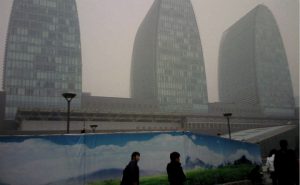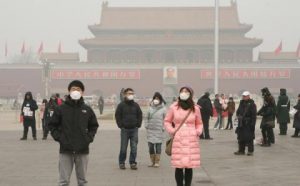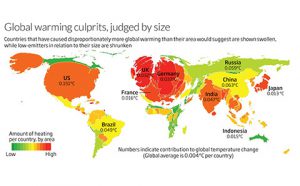The West is unwilling to end its dependence on fossil fuels. The UN climate negotiations have shown this for more than 20 years now. The latest round of UN climate talks in Warsaw, Poland in November 2013 saw no new pledges to reduce emissions from the rich industrialised countries. On the contrary, Australia and Japan turned their back on former commitments, joining the ranks of the US and Canada who had already dropped binding mitigation commitments in earlier years.
All countries have accepted 2C global warming above pre-industrial levels as the red line not to cross. Grave dangers loom beyond that point: the death of all coral reefs, the tipping over of the Greenland ice sheet and the possibility of “run-away” climate change.
Whether we stay below 2C is determined by the total amount of CO2 we emit globally, added up over the years. This cumulative carbon budget is a physical reality. Even if the UN climate negotiations still ignore the implications of the global carbon budget, it is a reality that we must get used to – and respond to. The laws of physics are obviously not negotiable. The global carbon budget for 2C is roughly 1000 Gigatons of CO2 (see IPCC 2013) and it is dwindling very fast – at a rate of 40 Gigatons per year. This would give us 25 years of current status quo consumption, then we would have to completely stop using fossil fuels. Of course, that’s not how it works, but it gives an idea.
Today, emissions are still growing. The issue is no longer one of “reducing emissions”. The issue has become one of completely phasing out fossil fuels over the next few decades.
Missing the 2C target is not an option. China already has millions of its own climate refugees from floods and the impacts of drought. The melting of Himalayan glaciers and of the permafrost of the Tibetan plateau are serious threats to the survival of millions of people who depend on the rivers fed by their meltwater, including the Yangtze and the Yellow River. The coastline is threatened by storms and floods and cities like Shanghai, Tianjin and Guangzhou will be under water, if the Greenland ice sheet melts completely.
A projected flood map of Shanghai and its surroundings – after the Greenland Ice Sheet melts
What can China do in this situation? Technologies exist for food, housing, energy, transport, clothing in a sustainable way. It is prices and priorities that are not right yet. The question is how to break the inertia in the current system and implement clean solutions quickly. Here are five suggestions:
1) Focus on quality of life for all – the logistics of decent food, water, housing and health care for all are possible with a dedicated effort. Neighbouring Bhutan measures the success of its policies against Gross National Happiness, instead of GDP. “Progress” in terms of “consumption of goods” comes with an increasingly higher price tag. But raising people’s happiness is a different game that can be won even in times of declining material throughput of the economy. In 1979 Deng Xiaoping said that the Confucian notion of a xiaokang society, one where people live modestly, was the goal of modernisation, and it has been invoked by a number of China’s leaders since.
2) Incentivise and promote Chinese companies to focus on producing services (such as transport or communication) instead of "goods" (such as cars, computers or cell phones). This shift in business models carries the potential for an immense decarbonisation and dematerialisation, and Western countries have not yet truly embraced that challenge. China could lead the way to the post-carbon age by promoting innovation in this sense.
3) Changing the rules of competition for companies in a way that promote a healthy environment and meet social goals can become integral to their business success. For example, in Austria, some companies prepare a yearly report on their promotion of the common good, social welfare, environmental and cultural goals. The more points they collect on a matrix, the more benefits from government (tax breaks, free public land, free pensions for their workers etc.) they will receive.
4) Speed up the energy transition to renewable energy. China has already shown its potential in bringing down costs and rolling out renewable energy infrastructure in record times. This successful strategy could bear even bigger fruits by matching it with an efficiency revolution that makes sure that much less (renewable) energy can achieve the same ends as formerly achieved with much fossil energy. A national long-term Transition Strategy to 100% renewable energy would certainly be a very powerful message to the world and immediately place China in front of the pack.
5) Promote future-proof urban design. Nowhere are so many new cities built as in China, but low-carbon infrastructure is not the norm yet. If you are planning a city, forget the family car, forget fossil heating and cooling. Gambling on fossil fuel availability in the future is a guarantee for disaster.








